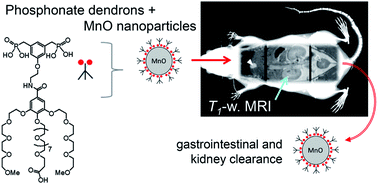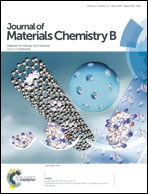Tailored biological retention and efficient clearance of pegylated ultra-small MnO nanoparticles as positive MRI contrast agents for molecular imaging†
Abstract
A majority of MRI procedures requiring intravascular injections of contrast agents are performed with paramagnetic chelates. Such products induce vascular signal enhancement and they are rapidly excreted by the kidneys. Unfortunately, each chelate is made of only one paramagnetic ion, which, taken individually, has a limited impact on the MRI signal. In fact, the detection of molecular events in the nanomolar range using T1-weighted MRI sequences requires the design of ultra-small particles containing hundreds of paramagnetic ions per contrast agent unit. Ultra-small nanoparticles of manganese oxide (MnO, 6–8 nm diameter) have been developed and proposed as an efficient and at least 1000× more sensitive “positive” MRI contrast agent. However no evidence has been found until now that an adequate surface treatment of these particles could maintain their strong blood signal enhancement, while allowing their rapid and efficient excretion by the kidneys or by the hepatobiliairy pathway. Indeed, the sequestration of MnO particles by the reticuloendothelial system followed by strong uptake in the liver and in the spleen could potentially lead to Mn2+-induced toxicity effects. For ultra-small MnO particles to be applied in the clinics, it is necessary to develop coatings that also enable their efficient excretion within hours. This study demonstrates for the first time the possibility to use MnO particles as T1 vascular contrast agents, while enabling the excretion of >70% of all the Mn injected doses after 48 h. For this, small, biocompatible and highly hydrophilic pegylated bis-phosphonate dendrons (PDns) were grafted on MnO particles to confer colloidal stability, relaxometric performance, and fast excretion capacity. The chemical and colloidal stability of MnO@PDn particles were confirmed by XPS, FTIR and DLS. The relaxometric performance of MnO@PDns as “positive” MRI contrast agents was assessed (r1 = 4.4 mM−1 s−1, r2/r1 = 8.6; 1.41 T and 37 °C). Mice were injected with 1.21 μg Mn per kg (22 μmol Mn per kg), and scanned in MRI up to 48 h. The concentration of Mn in key organs was precisely measured by neutron activation analysis and confirmed, with MRI, the possibility to avoid RES nanoparticle sequestration through the use of phosphonate dendrons. Due to the fast kidney and hepatobiliairy clearance of MnO particles conferred by PDns, MnO nanoparticles can now be considered for promising applications in T1-weighted MRI applications requiring less toxic although highly sensitive “positive” molecular contrast agents.

- This article is part of the themed collection: 2014 Journal of Materials Chemistry B Hot Articles

 Please wait while we load your content...
Please wait while we load your content...